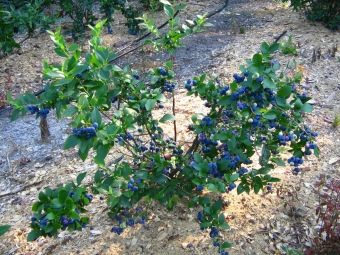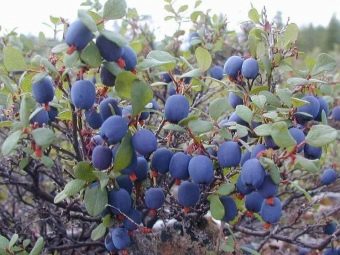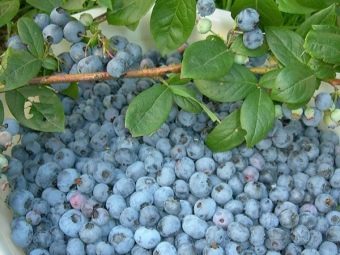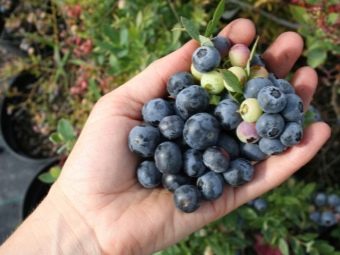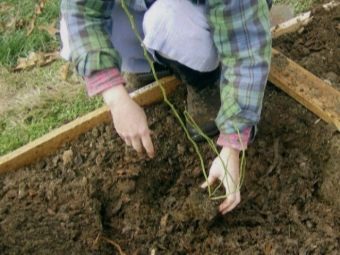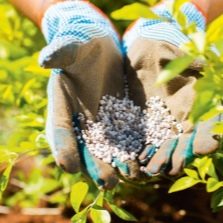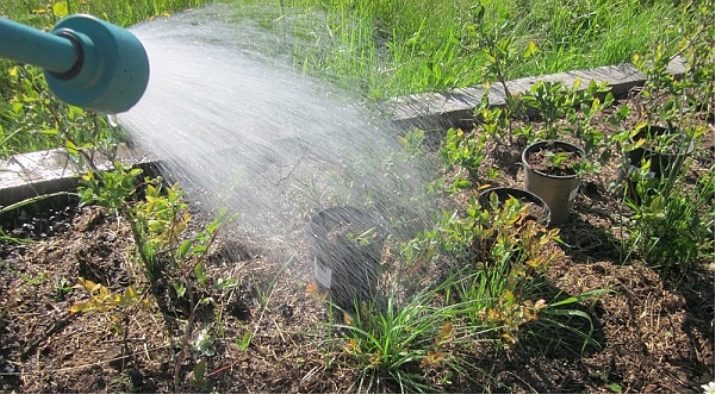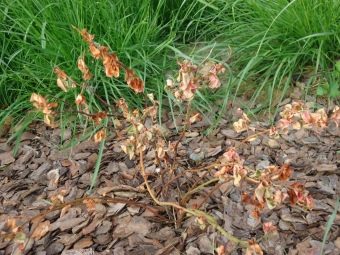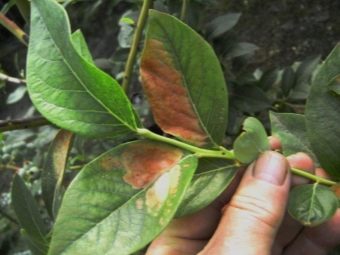Garden blueberries: features of growing delicious berries
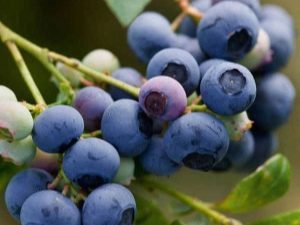
Garden blueberries have many names: the berry of millionaires, the berry of intellectuals and others. By themselves, the fruits have a huge amount of beneficial properties for the body. However, garden blueberries are a fastidious plant, and it is important to know how to take care of them in order to get a good harvest.
Features and differences from wild species and blueberries
Garden blueberries in country and private gardens are not grown as often. On the one hand, this berry has a great taste, the type is well kept both in the refrigerator and at room temperature. On the other hand, the same fruitful berry crop in the care must also be searched.
Many often compare this fruit plant with wild blueberries or blueberries. Indeed, there is a similarity, but it is rather controversial. Much more difference between plants.
So, garden blueberries differ from wild ones in the following criteria:
- The soil. If wild berries usually grow in swampy areas, the cultivated ones like soil with high acidity.
- The content of nutrients in the fruit. Sadly, the garden counterpart is so far inferior to the wild in the number of vitamins and trace elements it contains. However, this does not make garden blueberries completely useless: there are still some vitamins in it.
- Size of berries. If on a bush of wild blueberry berries are small and oval, then the garden one can be called large-fruited, with fleshy berries, which for a long time have not showered and burst.
- Height. Spray cultivated blueberries reach a height of 2.5 meters, those that are below a meter are considered as undersized. Wild berry literally spreads on the ground, its height rarely exceeds 30 cm.
- Fruiting. With proper planting and care, a garden bush will produce a crop for 2-3 years, while a wild berry needs 11–18 years to begin to bear fruit.
As for the differences from blueberry garden blueberries, they are as follows:
- blueberry bush lower than blueberry bush;
- stems on bilberry plant softer;
- blueberries have lighter stems than blueberries;
- blueberries grow steaming on the ground, and blueberries tend to the sky;
- It is possible to create conditions for the growth of blueberry anywhere, and blueberries only grow in pine forests;
- blueberry juice is dark, and blueberry juice is clear;
- blueberries have darker berries with a whitish bloom of a round color, and blueberries are slightly oblong and slightly lighter;
- Blueberries have a brighter flavor, blueberries are mostly acidic;
- Blueberries have dark blue flesh, and blueberries have a greenish tinge.
Cultivars
All cultivated varieties of garden blueberries are divided into three broad categories: early, mid-ripening and late. Judging by the reviews, late varieties are the best, since here the berries are juicy, large, fleshy, with a characteristic sugar taste.
note that none of the varieties will not pick up the desired taste, if not take care of the availability of the bush for insects.
It is important to plant blueberries at a short distance from other plants so that cross-pollination occurs. Then the yield will increase several times, and the harvest will be sweeter.
Many varieties are frost resistant. You need to choose the options with the best characteristics for the northern regions. This will not allow the bushes to freeze and divide. Among them:
- Vaccinium Corymbosum Duke. This species belongs to tall. The owners are pleased with large berries of 17-20 mm in diameter, slightly flattened oval in shape. Productivity - up to 8 kg from each bush. Maintains temperatures to-26 degrees.
- "Patriot". The bush grows medium - about 1.5 m in height. Productivity - up to 9 kg from each bush. The diameter of the berries is about 19 mm, they are flat and oval. Variety "Patriot" refers to one of the most pleasant to the taste. Differs in increased frost resistance: it can withstand temperatures up to -40 degrees.
- Bluecrop. The yield of this late-ripening shrub is up to 9 kg.The height can be up to 2 m. The variety is classified as frost-resistant, as it can withstand temperatures up to -34 degrees. Despite the fact that the berries are large and beautiful (up to 22 mm, they do not crack, it is fashionable to remove them even mechanically), they do not have a bright taste.
- Northland. Berries of this variety are early. The bush is up to 1.2 m in height, but it has a spreading crown. Fruiting - up to 8 kg from a bush, while berries can be stored and transported without spoiling. Often used for decorative purposes, because it does not have the same great taste as the look.
- Norhblue. The plant has a record low growth - only 90 cm. The yield is also small compared to others. So, from one bush can collect up to 3 kg of berries. Berries are fragrant and tasty, up to 18 mm in diameter. Variety refers to cold-resistant (up to -40 degrees), making it suitable for breeding in cold regions.
- "Taiga beauty". It is found both in the wild and in the gardens. The berries have a pleasant smell and slightly sour taste. They are large, do not crack, even with mechanical cleaning. The variety has been recognized for its winter hardiness: Blueberry "Taiga Beauty" can withstand temperatures up to -43 degrees.
- Elizabeth. One of the most delicious and fragrant varieties. Refers to late ripening varieties. Height - up to 1.8 m, yield - up to 7 kg. The berries are strong, dense, but poorly stored. Winter hardiness - up to -32 degrees.
- Bluejay Early variety. The height of the shrub can be up to 2 m, the yield from the bush - up to 6 kg. The berries are large, up to 2 mm in diameter. It is appreciated not only for tasty and fragrant berries, but also for excellent decorative properties. Frost resistance - up to -32 degrees.
- Elliot. This variety can not be called frost-resistant, so it is optimally grown in north-west Russia. Refers to late. The yield from one bush is up to 8 kg with high agricultural technology, the height of the shrub is up to 2 m. The berries are small (up to 15 mm), prone to shedding. The taste is sweet-sour, the smell is dull.
- "Marvelous". Variety refers to the middle: the harvest takes place from June to August. The bush grows low, up to 1.8 m. The berries are medium in size, slightly flattened, with a rich sour-sweet taste and a pronounced aroma. The plant is able to tolerate temperatures up to -42 degrees.
- "Canadian Blueberry Nectar". Plant height reaches 2 m. It has large oval berries of gray color with a whitish bloom. The taste is sweet and sour. The grade belongs to frost-resistant.
- Earliblue. Early fruiting shrub. Its height is up to 1.8 m, the yield from a bush is up to 7 kg. Fruits are light, spherical, up to 18 mm in diameter. They have a tart flavor and sweet-sour taste. Frost varieties - up to -37 degrees.
- Stanley. Early variety. Shrub reaches a height of 2 m, with the yield of one bush - up to 5 kg. Blueberries of this variety are used for drying or making jam, but are not very readily consumed fresh. Possesses high frost resistance.
- Ivanhoe. Tall variety. The height of the shrub is up to 2.3 m. The berries are large, the diameter reaches 18 mm. The fruits are dense, with a rich taste and tart flavor. Frost resistance - up to -27 degrees.
- Jersey. One of the most delicious varieties. The shrub does not exceed two meters in height, and up to 6 kg of berries can be harvested from the bush. The berries are small, up to 16 mm in diameter, have a sweetish taste. They are great for further processing: baking, cooking jams and the like. Frost resistance is good.
The choice of location and seedlings
Unlike its wild "relatives", garden blueberries do not tolerate marshiness and shading. A place for planting must be well lit, but it is desirable that within 1.5-2 meters other plants grow. This will contribute to a qualitative pollination of the shrub.
It is also important that the place for planting blueberry bushes is well protected from the wind. The gusty wind can tear the tender young bark, and also prevent the flowers from forming.
To ensure optimal protection, the lighted area should be fenced off with a hedge or fabric screen that eliminates wind exposure.
When choosing seedlings, you should first of all be guided by the climate you live in. Many varieties are cold-resistant, but if the winters in your region are snowless, you need to keep this in mind and look for a suitable variety. Also immediately think about how much time you are willing to devote to caring for blueberry bushes. If you do not have the proper amount of time, it is better to choose a less fastidious variety.
Optimal purchase annual seedlings, the trunk of which is already covered with young bark. It is easiest to plant them: they quickly take root, if you follow the agrotechnology.
It is important to weed out the weeds well at first, otherwise there is a risk that the young plant will not stand the competition and will die.
Having made a choice in favor of an annual sapling, you will be able to grow a fruiting shrub in 2-3 years.
What should be the ground?
Garden blueberries are fastidious when choosing soil. So, shrubs grow exclusively in acidic soil, while the level of acidity can vary in the range of pH 3.5-4.5. Also, do not use sandstones; the best choice is sandy-peat or loamy-peat soils. Chernozem also does not fit. It will have to be further acidified.
The best solution is to acidify only the soil in which the blueberry bush will directly grow. To do this, dig a square hole with sides of 60 cm and a depth of 50 cm, the walls of which are covered with waterproof plywood or specially treated against rotting boards. In this shank make drainage holes. Next, peat is poured to the bottom, and then - the soil in which the planting is planned.
You must first hold the area on which the blueberries will land, under the steam for several years. The fact is that the fungus that lives on the roots and comes into symbiosis with them, does not tolerate cultivated soil, so it must be free from any traces of plants. For the same reason, you need to perform a regular weeding area.
For additional acidification of the soil, you can use various techniques: water the soil with acidic water, add electrolytes or sulfuric acid to it. For measuring pH, it is better to use not a litmus test strip, but a pH meter: It gives a more accurate result, the error of which is only 0.01-0.02.
Planting and care
As mentioned above, planting blueberry bushes is best in a place specially prepared for this. Before you start planting, you need to consider a few rules:
- Be sure to pre-straighten the roots. Blueberry roots are very thin and tender, so they are called “angel hair”. The seedling can not be simply pulled out of the container, shoved into a hole, sprinkled with earth and left. Be sure to take care that the root system is fully located in the ground. So, you need 1-15 minutes to hold the container in water, so that the water saturate the earth. After that, the earthen room is carefully removed from the pot and gently by hand gently scrub the ground from the roots. If they are strongly intertwined, they are neatly separated and straightened out.
- You need to have a plant 5-6 cm deeper than it grew in a pot. Soil around the edges do not tamp, leaving the soil loose. Then periodically the land will need to be loosened.
When planting, be sure to sprinkle mulch from coniferous sawdust around the trunk. It additionally acidifies and nourishes the soil. You will also need the first watering to implement a bucket of sour water.
For the first time, all care is reduced to timely watering and checking the acidity of the soil, as well as timely disposal of weeds. They clog pores in the ground, making it difficult for a blueberry shrub to absorb the minerals needed for growth. The soil should be wet, but not very: when compressing a handful of earth should be felt the moisture, but it is impossible for water to flow down. Swampiness will lead to the death of the plant.
Preparing for the winter
For the winter, blueberry bushes must be covered.This applies to both stunted and tall plants. Despite the cold-resistant characteristics, the branches can freeze and die, especially in tall ones.
In the case of stunted shrubs, it suffices to take care only that they are always under the snow. To do this, periodically sprinkle with snow sticking tops. As a rule, low bushes tolerate wintering well.
As for tall plants, it is necessary to adhere to the following sequence of actions:
- First you need to bend the shrubs to the ground. For these purposes, the most suitable ordinary twine. It is necessary that the bushes are no higher than 30-40 cm.
- Next, fit a special material designed to protect blueberries from frostbite. It is necessary to use natural porous materials, such as spunbond or burlap. Polyethylene is categorically not suitable for sheltering blueberry bushes. For fixing use pegs.
Properly protecting the plant in the winter, you minimize the risk that it will die due to severe frosts. Please note that the winter shelter need even frost-resistant varieties. Usually, frost resistance is indicated already taking into account that the plant will be properly covered during the winter period, and also covered with snow. It is considered normal if only extreme branches are frozen.
Pruning and dressing
Especially intensive care for the plant should be in the spring, especially if it was planted in the fall and suffered its first wintering. Keep in mind that it is recommended that all planting work be carried out in the spring so that the young sapling has time to grow stronger over the summer.
The first step is to prune the plant. Trimming is carried out for several purposes:
- to get rid of frostbitten and dead shoots;
- in order to thin out too bushy;
- to increase fertility.
You need to trim only those branches that:
- too close to the ground;
- grow inside the shrub;
- are branched "palm trees" at the ends of strong young shoots.
The rest is better not to touch.
As for fertilizers, not everyone is suitable. So, in no case can not be fertilized with organic matter: manure, chicken litter, ash and other things. You can kill the plant in record time, and you may not even be aware of your mistake. Just accept as an axiom: you cannot feed with organic matter.
If you still want to feed a little plant, the best solution would be to use fertilizers for the rhododendron family, as well as the following compounds: superphosphate, potassium magnesia, fertilizer for conifers.
Also be guided by the appearance of the plant. On it you can immediately understand what the shrubs lack: nitrogen, phosphorus, potassium, or maybe boron. The main thing - do not confuse the signals about the lack of any substances with the disease.
Watering and harvesting
Blueberries should grow in moist soil, but not in wet, so only natural precipitation is not enough for it. Watering should be carried out twice a week, and in particularly dry seasons - every other day. In case of strong heat, spraying with warm water should be used twice a day: in the morning before the sun starts to burn, and in the evening after sunset.
Do not water the shrubs directed stream. So you risk too tamp the soil. It is best to carry out watering under a gentle pressure with a spray nozzle or a watering can by hand.
The ripeness of the berries is determined by their appearance. Initially, the fruits have a greenish-pink color. At the moment when they are gaining a bluish color, they can be considered almost ripe.
After a set of colors, it is important to allow the berries to ripen for about a week, so that they will be candied, become sweet and soft. Freshly ripened fruits are firm and sour.
Harvest is best done by hand, in parts. The berry should be easily separated from the stem, and the place of attachment should be dry.Since the berries do not fall, it is possible to shoot them with weekly breaks in order to achieve maximum maturity and taste. It is preferable to use fresh berries of the first and second collections, as they are the most delicious and healthy. Then the fruit is crushed, and it is better to let them for processing.
Typical diseases
Like all other plants, garden blueberries are subject to infection by certain diseases. It is important to examine them at an early stage in order to take action in time and not to lose the entire crop.
Often for the disease take only a deficiency of any of the trace elements: phosphorus, nitrogen and others. However, when a plant is deficient, completely different symptoms appear:
- With a lack of nitrogen, you can notice the yellowing of the leaves, which over time become reddish. Berries are much smaller.
- If not enough phosphorus, the leaves become saturated purple color. At the same time, they settle down, clinging to the stalks.
- In potassium deficiency, young shoots have black tips that die. Leaves fall away.
- When there is not enough calcium, one can notice a strong deformation of the leaves, yellowing of the edges.
- With a magnesium deficiency, the edges of the leaves turn yellow while maintaining a green color in the center.
- The lack of boron primarily affects the leaves of the apex: they become bluish. Shoot growth becomes slow, gradually fading away, and in the process the newly formed shoots die off.
- When iron deficiency is observed, the leaves turn yellow, while the veins retain a green color. This is most noticeable on the leaf tops.
- With a lack of sulfur, the leaves first become brownish-yellowish, and then completely turn white.
As you can see, any of these symptoms is just a sign that the plant needs to be fertilized. A completely different thing is root or viral diseases:
- stem cancer;
- fomopsis;
- septoriosis;
- botritis;
- coccomycosis;
- anthracnose;
- monilioz;
- mosaic;
- dwarfism;
- necrotic spotting;
- filamentous branches.
In case of infection with one of the diseases, the plant is likely to die.
See the next video for more information on cultivating garden blueberries.



